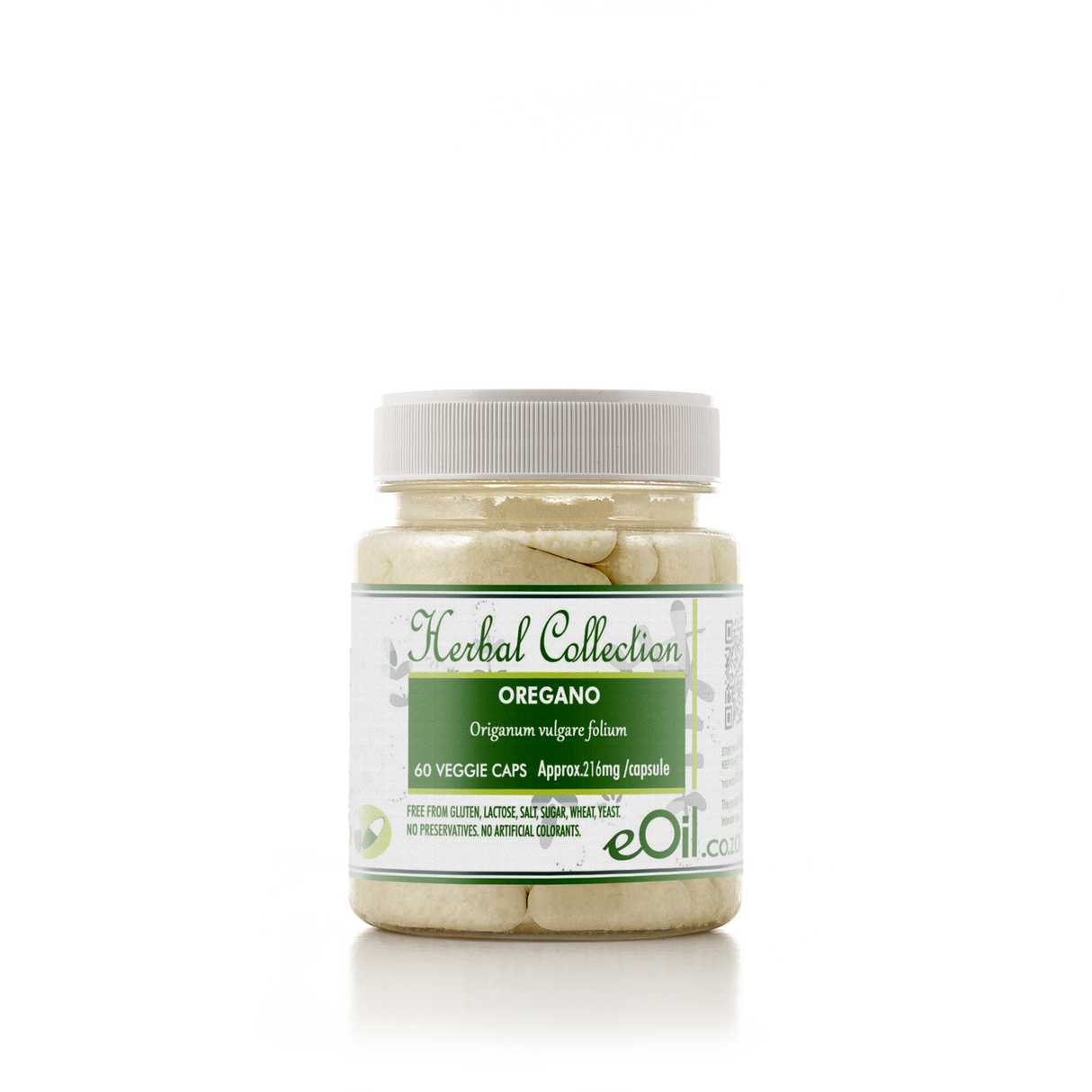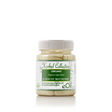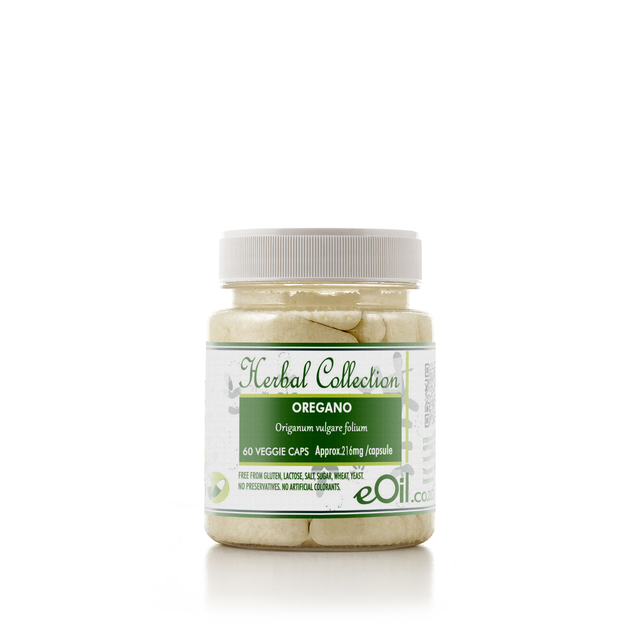Oregano vegan capsules - Herbal Collection
Oregano vegan capsules - Herbal Collection is backordered and will ship as soon as it is back in stock.
Description
Description
Oregano Rubbed - 60 capsules - Herbal Collection
Dried oregano, a staple herb in Mediterranean cuisine, is known for its pungent aroma and savory flavor.
Beyond its culinary uses, oregano boasts potential wellness benefits due to its naturally occurring compounds.
It has been traditionally used to support digestive health and may contribute to respiratory well-being.
Its versatility makes it a popular addition to various dishes and herbal preparations.
For in depth information check tabs below
TRADITIONALLY USED FOR
Oregano (Origanum vulgare) is a popular herb belonging to the Lamiaceae family, native to the Mediterranean region and Eurasia.
It is commonly used as a culinary spice but also has a long history of traditional use in various cultures for its medicinal properties.
Here are some benefits, properties, and traditional uses of oregano:
- Antioxidant properties: Oregano is rich in phenolic compounds, such as rosmarinic acid and thymol, which have potent antioxidant properties. These antioxidants can help neutralize harmful free radicals in the body, reducing oxidative stress and potentially lowering the risk of chronic diseases.
- Antibacterial and antiviral properties: Oregano has demonstrated antibacterial and antiviral effects due to its essential oil content, particularly carvacrol and thymol. These compounds can inhibit the growth of harmful bacteria and viruses, supporting the immune system in fighting infections.
- Anti-inflammatory properties: Oregano contains compounds that possess anti-inflammatory effects, which can help reduce inflammation in the body and alleviate symptoms associated with inflammatory conditions like arthritis.
- Digestive health: Traditionally, oregano has been used to treat various digestive issues such as bloating, gas, and indigestion. Its carminative properties may help soothe the gastrointestinal tract and promote healthy digestion.
- Respiratory health: Oregano has been traditionally used to alleviate symptoms of respiratory illnesses like coughs, colds, and bronchitis due to its expectorant and antimicrobial properties.
- Menstrual health: Oregano has been used in traditional medicine to regulate menstruation and alleviate menstrual cramps. It is thought to have emmenagogue properties, which can stimulate blood flow in the pelvic area and promote regular menstruation.
- Skin health: Applied topically, oregano oil may help treat various skin conditions such as acne, fungal infections, and insect bites due to its antimicrobial and anti-inflammatory properties.
INFORMATION
Source : http://www.wikiphyto.org/wiki/Oregano
Reference on http://www.wikiphyto.org
Translation in English by Google Translate (go to the page of the source linked | on Chrome cellphones go on the 3 dots on the top right and select translate in your preferred language | on laptop right click your mouse and select option translate when hoovering on the page
plant name
Oregano, common oregano or true oregano , wild marjoram
International Latin denomination
Origanum vulgare L. ssp
botanical family
Lamiaceae
Description and habitat
- 80 cm high perennial (subshrub) with quadrangular red stems, small elliptical opposite leaves, purple-pink flowers in panicles
- Europe, Middle East, North America
- Dry calcareous soils, seaside
History and tradition
- Platearius [1] says that it "divides the humours, consumes the ventosities", "releases the humours and humidity" from the gums, throat and uvula, treats asthma, soothes the pains of the stomach and intestines. He recommends putting tampons soaked in oregano powder on the foundation in case of strains (or tenesmus, spasms of the anus and false needs caused by hemorrhoids, among other things). In a hot sitz bath, it "makes the flowers run" (returning the rules), but a suppository of young shoots "introduced into the duct" will be more effective
- Oregano is widely used as a condiment in pizzas.
- Taxonomy and chemotaxonomy are complex, (many races and chemical types), be careful to be precise with the Latin binomial name
- The Greeks planted it on the graves to rejoice the deceased
- Vulnerable species or “Swiss tea” from the 1949 Codex: Absinthe leaves and tops , Betonia , Calament , Germander, small oak , Hyssop , Ground ivy , Oregano , Periwinkle , Rosemary , Sage officinalis , Scolopendra , Scordium , Thyme , Veronica officinalis ; flowers of Arnica , Pied-de-chat , Coltsfoot ; in equal parts
Parts used
- Flowering tops
- Flowering tops essential oil
Dosage forms available
- Origanum vulgare tincture whole plant
- Flowering tops essential oil
Usual dosages
Composition
Main components of the plant
- Majority carvacrol essential oil
- Tannins
- Flavonoids : Luteolin , apigenin and naringenin glycosides
- Phenolic acids
Main components of buds or young shoots
Main components of essential oil
- Phénols terpéniques : carvacrol, thymol
- Terpene hydrocarbons : gamma-terpinene , paracymene , beta-bisabolene , caryophyllene , alpha-phellandrene , beta-myrcene , alpha-terpinene , alpha-pinene
- Monoterpene alcohols : linalool , borneol , alpha-terpineol , terpinene-4-ol
- A variety of oregano, Origanum vulgare var. kaliteri (native to Greece) contains trans-4-thujanol , terpinene-4-ol , cis-4-thujanol , alpha-terpinene , gamma-terpinene , sabinene , carvacrol (less than 10%), making it more balanced
Properties
Plant properties
- Antiseptic, antibacterial [2]
- Antifungal [3]
- Expectorant
- Emmenagogue
- Carminatif
- Increases bile secretion
- Aperitif
- Immunostimulant
- antioxidant
- Anti-lithiasis: inhibits the aggregation of calcium oxalate crystals, protects renal epithelial cells, antispasmodic effect [4]
Bud properties
Properties of essential oil
- Antibacterial [5] , against Listeria monocytogenes, Salmonella typhimurium, Escherichia coli O157:H7 [6]
- Oregano EO Origanum vulgare exhibits antibacterial effect against Propionibacterium acnes and Staphylococcus epidermidis , with strong anti-biofilm effect against S. epidermidis , oregano EO nanoemulsion can treat acne and prevent antibiotic resistance [7]
- Antifungal [8] , [9] , [10] , [11]
- Immuno-stimulant (increase in CD4 and CD8, T lymphocytes in pigs whose diet is enriched with oregano and essential oil )
- Antioxidant essential oil due to the richness in phenolic compounds , thymol and carvacrol
- Inhibits the formation of peroxynitrites [12]
Indications
Indications of the whole plant (phytotherapy)
- Cough, angina, bronchitis, asthma
- Period delay
- Urinary tract infections
- Hepatobiliary insufficiency ( flavonoids )
- External use: cracks, cracks, mouthwashes as oral analgesic, stuffy nose
Indications of the bud (gemmotherapy)
Specific indications of essential oil (aromatherapy)
Known or suspected mode of action
- The essential oil is immuno-stimulant and antioxidant due to the richness in phenolic compounds ( thymol , carvacrol )
Usual formulations
Regulations
- French Pharmacopoeia list A (leaf, flowering top)
Possible side effects and precautions for use
Bibliographic references
- Go↑ Platearius Mattheus. The Book of Simple Medicines from the French manuscript 12322 of the National Library of Paris. Ghislaine Malandin and Pierre Lieutaghi, Paris, Ozalid and Cardinal Texts, 1986, 361 p. 2nd ed.: 1990
- Go↑ Saeed S, Tariq P. Antibacterial activity of oregano (Origanum vulgare Linn.) against gram positive bacteria. Pak J Pharm Sci. 2009 Oct;22(4):421-4. PMID: 19783523
- Go↑ Vijaya Manohar, Cass Ingram, Judy Gray, Nadeem A. Talpur, Bobby W. Echard, Debasis Bagchi, Harry G. Preuss. Antifungal activities of origanum oil against Candida albicans. Molecular and cellular biochemistry, Volume 228, Numbers 1-2, 111-117
- Go↑ Khan A, Bashir S, Khan SR, Gilani AH. Antiurolithic activity of Origanum vulgare is mediated through multiple pathways. BMC Complementary and Alternative Medicine 2011, 11:96 (17 October 2011) résumé [1], texte intégral [2]
- Go↑ Birol Özkalp, Fatih Sevgi, Mustafa Özcan, Mehmet Musa Özcan. The antibacterial activity of essential oil of oregano (Origanum vulgare L.). Journal of Food, Agriculture & Environment Vol.8 (2): 272-274. 2010 texte intégral
- Go↑ Karakaya S, El SN, Karagözlü N, Sahin S. Antioxidant and antimicrobial activities of essential oils obtained from oregano (Origanum vulgare ssp. hirtum) by using different extraction methods. J Med Food. 2011 Jun;14(6):645-52. PMID 21314366
- Go↑ Taleb MH, Abdeltawab NF, Shamma RN, Abdelgayed SS, Mohamed SS, Farag MA, Ramadan MA. Origanum vulgare L. Essential Oil as a Potential Anti-Acne Topical Nanoemulsion-In Vitro and In Vivo Study. Molecules. 2018 Aug 28;23(9):2164. doi: 10.3390/molecules23092164. PMID 30154336; PMCID: PMC6225355.
- Go^ Marlete Brum Cleff, Ana Raquel Meinerz, Melissa Xavier, Luiz Filipe Schuch, Mário Carlos Araújo Meireles, Maria Regina Alves Rodrigues, João Roberto Braga de Mello. In vitro activity of Origanum vulgare essential oil against Candida species. Brazilian Journal of Microbiology, vol. 41, no. 1, 2010 full text [3]
- Go↑ Pozzatti P, Scheid LA, Spader TB, Atayde ML, Santurio JM, Alves SH. In vitro activity of essential oils extracted from plants used as spices against fluconazole-resistant and fluconazole-susceptible Candida spp. Can J Microbiol. 2008 Nov;54(11):950-6. PMID 18997851
- Go↑ Konstantia Adam, Afroditi Sivropoulou, Stella Kokkini, Thomas Lanaras, Minas Arsenakis. Antifungal Activities of Origanum vulgare subsp. hirtum, Mentha spicata, Lavandula angustifolia, and Salvia fruticosa Essential Oils against Human Pathogenic Fungi . J. Agric. Food Chem., 1998, 46 (5), pp 1739–1745. DOI: 10.1021/jf9708296 [4]
- Go↑ Felšöciová S, Kačániová M, Horská E, Vukovič N, Hleba L, Petrová J, Rovná K, Stričík M, Hajduová Z. Antifungal activity of essential oils against selected terverticillate penicillia. Ann Agric Environ Med. 2015; 22 (1): 38-42. doi: 10.5604 / 12321966.1141367. PMID 25780826
- Go↑ Josè M. Prieto, Patrizia Iacopini, Pierluigi Cioni, Silvio Chericoni. In vitro activity of the essential oils of Origanum vulgare, Satureja montana and their main constituents in peroxynitrite-induced oxidative processes. Food Chemistry, Volume 104, Issue 3, 2007, Pages 889–895
- Teuscher Eberhard, Anton Robert, Lobstein Annelise. Aromatic plants: Spices, herbs, condiments and essential oils. Ed. Tec & Doc. Cachan. 2005. p. 361
- Franchomme, Penoel. Aromatherapy exactly. Ed. Roger Jollois. 1996. p. 383
- Walter BM, Bilkei G. Immunostimulatory effect of dietary oregano etheric oils on lymphocytes from growth-retarded, low-weight growing-finishing pigs and productivity. Tijdschr Diergeneeskd. 2004 Mar 15;129(6):178-81. PMID 15052959
- Faleiro L, Miguel G, Gomes S, Costa L, Venancio F, Teixeira A, Figueiredo AC, Barroso JG, Pedro LG. Antibacterial and antioxidant activities of essential oils isolated from Thymbra capitata L. (Cav.) and Origanum vulgare L. J Agric Food Chem. 2005 Oct 19;53(21):8162-8.
- Kusilic T, Radonic A, Katalinic V, Milos M. Analytical, nutritional and clinical methods use of different methods for testing antioxydative activity of oregano essential oil. Food Chem. 2004. 85: 633-640.
- Lambert R.J.W., Skandamis P.N., Coote P.J., Nychas G.-J.E. A study of the minimum inhibitory concentration and mode of action of oregano essential oil, thymol and carvacrol. Journal of Applied Microbiology. September 2001, Volume 91, Issue 3, Page 453.
CAUTION
Store in a cool, dry place, away from light. Keep tightly closed, away from the reach of Children and pets.
Do not exceed the daily dose.
This product is not intended to prevent or cure any form of illness or disease.
If you are pregnant or nursing ; If you have a medical condition or are in the course of medical treatment ; If you are programmed for theater/operation in the near future, please consult your healthcare practitioner before using this product.
This product cannot replace a varied and balanced diet and a healthy lifestyle.
This product has not been evaluated by the SAHPRA for its quality, safety or intended use.
For More Information please check our General Safety Herbal products Page





